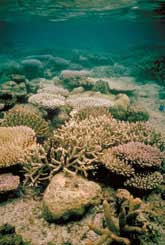
skip to content program navigation
| Learn more about these CLIMATE RESEARCH areas... |
Paleoclimatology
Paleoclimatology is the study of climate prior to the widespread availability of records of temperature, precipitation and other instrumental data. NOAA is particularly interested in the last few thousand years because this is the best dated, best sampled part of the past climatic record and can help us establish the range of natural climatic variability in a period prior to global-scale human influence.
Unfortunately, records of past climate change from satellites and human measurements (thermometers, rain gauges) generally cover less than 150 years. These are too short to examine the full range of climatic variability. For this reason, it is critical to examine climate change going back hundreds and thousands of years using paleoclimatic records from trees, corals, sediments, glaciers and other natural or "proxy" sources.
Environmental recorders can also be used to estimate past climatic conditions and thus extend our understanding far beyond the 100+ year instrumental record. "Proxy" records of climate have been preserved in tree rings, locked in the skeletons of tropical coral reefs, extracted as ice cores from glaciers and ice caps, and buried in laminated sediments from lakes and the ocean.
Why Should We Care About Climate Change?
There are several reasons why scientists study paleoclimate. For example, understanding how climate has changed on interannual to interdecadal time scales in the past can help us understand how climate may change in the future. The paleoclimate record also illustrates that the earth's climate has been subject to abrupt change. For example, changes in the frequency of extreme events such as droughts, floods and storms has a large impact on humans. Since a severe El Niño, or a drought lasting on order of a year can cost US citizens billions of dollars. Since the paleoclimate record shows that the Earth's climate system is capable of shifting dramatically to a different climate state, changes in the frequency and intensity of extreme events may be a symptom of this process. Understanding these "climate surprises" of the past is critical if we are to avoid the consequences of abrupt climatic change. It is important that scientists study abrupt climate change, as well as changes in the frequency and intensity of the past climate to enable society to prepare for potential future climate change.
The study of past climate change also helps us understand how humans influence the Earth's climate system. The climatic record over the last thousand years clearly shows that global temperatures increased significantly in the 20th Century, and that this warming was likely to have been unprecedented in the last 1200 years. The paleoclimatic record allows us to examine the causes of past climate change, and to help unravel how much of the 20th century warming may be explained by natural causes and how much may be explained by human influences.
|
Reef flat, Palau Archipelago (Micronesia)
Locations of Tree-Ring Chronologies. More information about this image
An iceberg like this caused the sinking of the Titanic. More information about this image |
NOAA Research programs that study Paleoclimatology
![]() Climate Program Office (CPO)
Climate Program Office (CPO)
![]() National
Climatic Data Center (NCDC)
National
Climatic Data Center (NCDC)
Additional Related Information
- NOAA's Coral Paleoclimatology
- Climate Timeline
- Data Access & Data Contribution
- Paleoclimatology Slide Sets
- Paleo Perspectives



